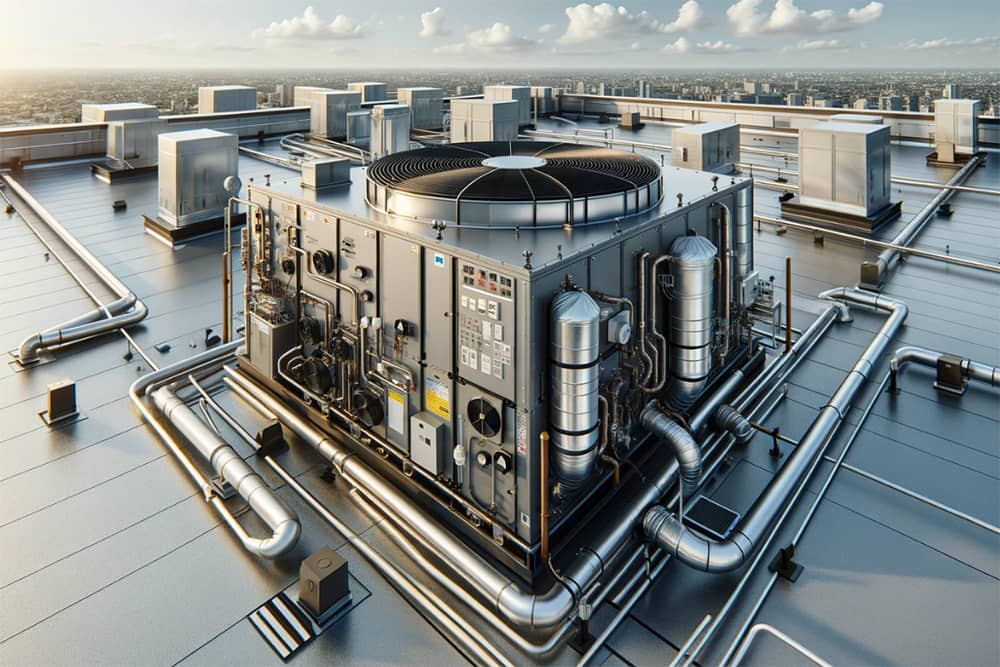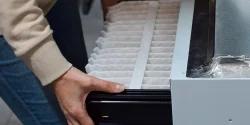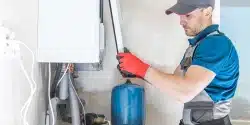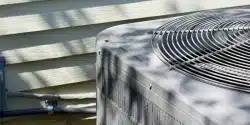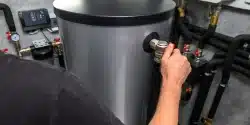RoofTop HVAC
HVAC Rooftop Units (RTUs) have emerged as a cornerstone of modern heating, ventilation, and air conditioning in commercial building management. These units, strategically installed on rooftops, offer a unique combination of efficiency, space-saving design, and environmental benefits. This comprehensive guide aims to provide an in-depth understanding of RTUs, focusing on their environmental impact, space and efficiency maximization, cost-effectiveness, and essential considerations for installation and maintenance.
The Environmental Impact of Rooftop Units in Commercial Buildings
Energy Consumption: The Efficiency Paradigm
RTUs are significant players in a building’s energy dynamics. Contemporary designs emphasize energy efficiency, significantly reducing the environmental impact of commercial buildings. Selecting an RTU with a high Seasonal Energy Efficiency Ratio (SEER) rating ensures lower energy consumption, aligning with environmental sustainability goals. Advanced features like variable speed fans and modulating compressors optimize energy usage, making modern RTUs eco-friendly.
Sustainability Aspects: Eco-Conscious Engineering
Today’s RTUs are increasingly designed with sustainability in mind. Compliance with green building standards, such as LEED and BREEAM, is becoming standard. These units often feature eco-friendly refrigerants, like R-410A, with lower ozone-depleting potential than traditional refrigerants. Enhanced insulation materials and energy recovery ventilators (ERVs) are also integrated to reduce energy loss, bolstering the unit’s sustainability credentials.
Maximizing Space and Efficiency with Rooftop HVAC Units
Space Optimization: The High Ground Advantage
One of the most significant advantages of RTUs is their space-saving nature. These units free up ground or internal building areas by occupying unused rooftop spaces for more productive use. This spatial optimization is particularly beneficial in urban settings where space is premium.
Efficiency Enhancement: Smart Integration
Modern RTUs are often part of a building’s integrated management system. Equipped with advanced sensors and controls, these units can adapt to varying occupancy levels and weather conditions, modulating their output for maximum efficiency. This integration enhances energy efficiency and improves indoor air quality, contributing to a healthier indoor environment.
Cost-Effectiveness and Energy Efficiency of Rooftop Units
Long-term Financial Benefits: An Investment Perspective
While the initial cost of an RTU can be substantial, the long-term savings are considerable. Though more expensive upfront, energy-efficient models lead to lower utility bills and maintenance costs over time. Additionally, many regions offer incentives and rebates for installing energy-efficient RTUs, further offsetting the initial investment.
Reducing the Carbon Footprint: Environmental Economics
The environmental benefit of energy-efficient RTUs extends beyond mere cost savings. By consuming less power, these units contribute to reduced greenhouse gas emissions, a crucial factor in the global fight against climate change. This reduced carbon footprint aligns with corporate sustainability goals and resonates with increasingly eco-conscious consumers and stakeholders.
Installation and Maintenance Considerations for Rooftop HVAC Units
Installation: A Task for Experts
Installing a Rooftop HVAC Unit (RTU) is a complex and nuanced process requiring high expertise and precision. It’s far more intricate than merely placing a unit atop a building.
1. Load Calculations: Ensuring Right Size and Capacity
The foremost step in RTU installation is conducting accurate load calculations. This process involves determining the heating and cooling demands of the building, considering factors like size, layout, insulation levels, window placements, and occupancy. An improperly sized RTU can lead to inefficiencies, increased wear and tear, and inadequate temperature control.
2. Ductwork Compatibility and Integration
Integrating the RTU with the existing ductwork is a critical aspect. The duct system must be inspected and potentially modified to ensure it can efficiently distribute air from the new unit. Proper duct sizing and sealing are crucial to prevent air loss and maintain system efficiency.
3. Structural Integrity: Assessing Rooftop Suitability
A key consideration before installation is assessing the structural integrity of the building’s roof. RTUs are heavy, and the roof must support their weight without risk of damage. Structural engineers often play a role in this assessment to ensure safety and compliance with building codes.
4. Access and Safety
Safe and easy rooftop access is essential for installation and future maintenance. Factors such as the unit’s location on the roof, accessibility for service personnel, and adherence to safety regulations are vital considerations.
5. Electrical and Plumbing Connections
Ensuring that the RTU is correctly connected to the building’s electrical and plumbing systems is vital. This includes establishing power connections and drainage for condensate and refrigerant lines, all requiring skilled technicians to install and test.
Maintenance: The Key to Longevity
Regular maintenance is pivotal for the optimal functioning and longevity of an RTU. A well-maintained unit operates more efficiently and has a significantly longer lifespan.
1. Air Filter Maintenance
Changing or cleaning air filters is one of the most basic yet essential maintenance tasks. Dirty filters restrict airflow and reduce efficiency, leading to higher energy consumption and strain on the unit. Filters should be checked and replaced or cleaned regularly, depending on the type and usage of the unit.
2. Belts and Motors Inspection
Belts and motors should be inspected periodically for signs of wear and tear. Loose or damaged belts can affect the operation of the fan and blower, while faulty motors can lead to a complete system breakdown. Regular lubrication of motors and adjustments of belts can prevent these issues.
3. Refrigerant Levels Check
Maintaining the correct level of refrigerant is crucial for the efficient operation of an RTU. Low refrigerant levels can indicate leaks, which not only reduce efficiency but can also be harmful to the environment. A qualified technician should handle refrigerant checks and repairs.
4. Electrical Components and Controls
Inspecting and testing electrical components, including thermostats, contactors, and capacitors, is vital to ensure they function correctly. Faulty electrical components can lead to inefficient operation and even safety hazards.
5. Coil and Condensate Drains Cleaning
The condenser and evaporator coils should be cleaned regularly to ensure efficient heat transfer. Additionally, condensate drains should be checked and cleared to prevent water accumulation and potential damage to the unit or building.
6. Seasonal Inspections
Scheduling professional inspections and maintenance before peak heating and cooling seasons can help identify and address potential issues, ensuring the unit operates reliably when needed.
The installation and maintenance of an RTU are critical components of its overall performance and lifespan. Professional installation ensures the unit is correctly sized, efficiently integrated, and safely mounted. On the other hand, regular maintenance is essential for maintaining efficiency, preventing costly repairs, and extending the unit’s service life. By prioritizing these aspects, building managers can ensure that their RTU systems operate optimally for years to come.
Working with Kelowna HVAC Experts: Husky Heating and Cooling
For those in the Kelowna area, navigating the complexities of HVAC rooftop units becomes significantly more accessible with the expertise and Cooling. ThiCooling’s expertise-operated company prides itself on offering honest, ethical, and professional services. Their commitment to excellence is evident in their approach to every project, whether it’s a new installation, routine maintenance, or complex repair work.
Fully insured and bonded, Husky Heating and Cooling understands the unique challenges and requirements of managing RTUs. Their team’s expertise ensures that clients receive solutions that are not just effective but also sustainable and cost-efficient.
RTUs represent a significant advancement in commercial HVAC systems, offering efficiency, space utilization, and environmental benefits. Their role in modern building management cannot be overstated. With the right approach to selection, installation, and maintenance – and with the expertise of professionals like Husky Heating and Cooling – these systems can provide optimal performance and significant cost savings and contribute to a more sustainable future.
Understanding the nuances of your HVAC rooftop unit is critical to maximizing its benefits and ensuring its longevity. This guide is a comprehensive resource for anyone looking to deepen their knowledge of RTUs and make informed decisions about their HVAC needs.

